In order to leave Nouakchott without the traffic, where the taxis stop anywhere and overtake from both sides, I head directly to the coast from the Auberge Sahara and take the road of the ports. The auberge was a travelers’ place with a nice atmosphere, for a change of cheap hotels for locals. The road of the ports bypasses nicely the whole town, passing through the fishing port, then the commercial port. It’s a rather smelly and dirty road, but completely avoids the unpredictable traffic of Nouakchott, for a smooth exit and a positive start of the day.
The road in the south of Nouakchott can’t be described as beautiful. It’s a mix of the desert, sand everywhere, with bushes and small trees. It gets quickly monotonous and not as nice as in the desert before the capital. The sand and stones are grey. The poor vegetation is more and more present, yet looking still unsuitable for attracting animals bigger than insects. This road is however much more inhabited, with many villages and houses along, a sign that the Sahara is maybe over. The goats are as numerous as anywhere else but the camels are progressively replaced by cows.
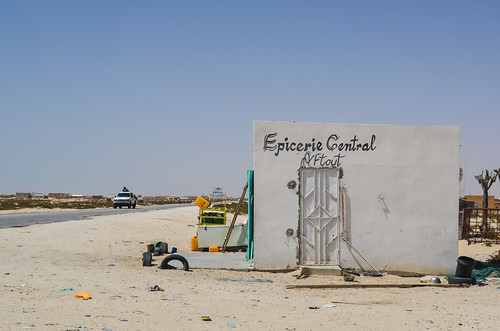
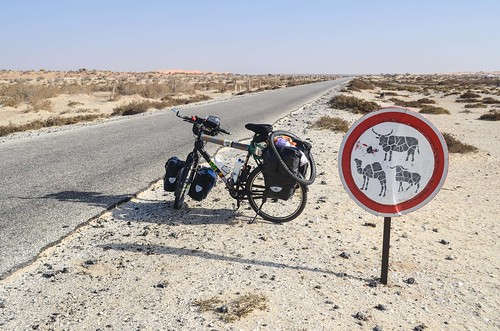
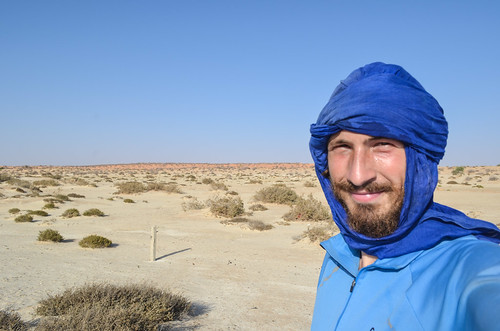

There is a gendarmerie checkpoint just before Tiguent, a small town of 10’000 on the way to Rosso, the Senegalese border. I have no more fiche to hand over, so I am ready for a little chat while the gendarmes while they note down my passport details (on a piece of paper probably to be lost).
However, the chef is listening to his small radio on the hood of the gendarmerie’s Toyota Hillux. There is Paris SG – Barcelona right now and, as a 100% supported of the Barca, he is too absorbed in it. He just says “OK” to me not having a fiche and asks no further details.
It reminds me that I was asked a fiche when I passed the customs checkpoint before Nouakchott (there are 4 kind of checkpoints on the road: gendarmerie, police, customs, and road safety), but I was returned it when I said it was my last one and I’d rather give it to the gendarmes. Those events, added to the times the officer copied my passport details with mistakes, is not giving credibility to the “it’s for your security” so often said to justify the many controls on the road. Anyway, that’s already a lot of efforts by the government to watch after the few tourists in the region.

In the end, I cycled 120 km in a day started at noon, sign of a helping wind, a straightforward flat road, and poor in sights. Those kind of very “efficient” days will soon be over with the roads becoming less straightforward and more interesting after Mauritania.
After Tiguent, the road has even more villages along, like every 5 km, and tiny slopes uphill and downhill.
In some of the villages, the kids just wave at me. In some they run and shout (for presents). I have even been thrown stones and stuff at me, by very small kids, like if it was a game.
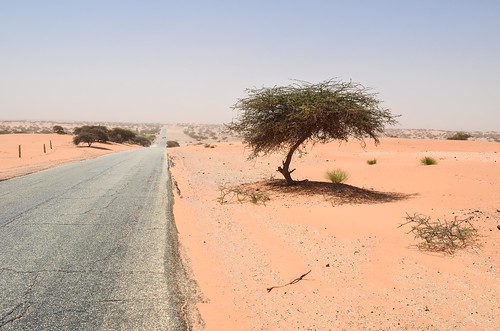
It is still hot in this landscape, a mix of desert and savanna. Sometimes the sand is grey, sometimes yellow. The milestones are now every kilometers but the road quality seriously dropped since Nouakchott. The sides are broken and many potholes and cracks make the traffic, including me, slower.

There are many taxis, certainly doing the link between the capital and the Rosso border post. They are all Renault 19 very loaded, with the back almost touching ground. They carry 7 persons (3 front, 4 back) and as much stuff as the rooftop can carry.
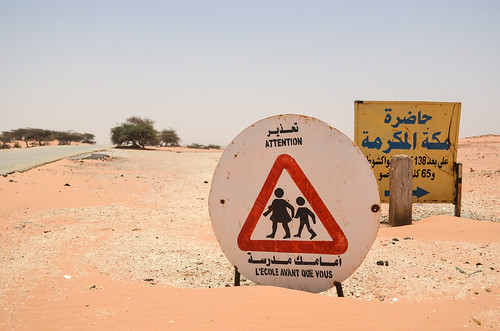
The many villages allow me to make several “coca-cola breaks” to refresh from the hotness. In one shop I see a kid learning the Quran from a wooden plate. This is close to where I leave the main road for the piste to Diama.
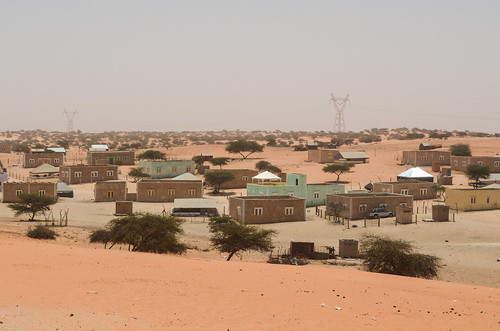
There are 2 ways to exit Mauritania: the main border with Senegal is at Rosso, a ferry-crossing known for its hassling officials and touts (probably getting worse with foreigners being prepared to give cash to anyone), and the other one is at Diama, a digue at the Senegal river mouth with a bridge. I choose the second one, both for avoiding the hassle (albeit I was certified it can go normally if you are prepared and don’t do mistakes) and for the road. The road is actually a piste, crossing the Diawling National Park.
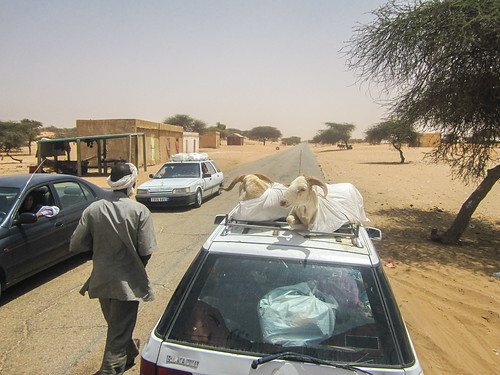
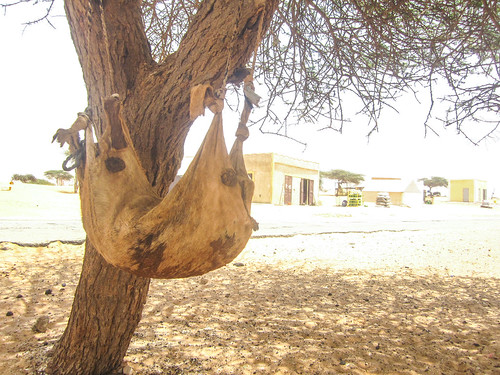
The road to Diama is a brand new nice and wide asphalt for about … 2 kilometers. Then I have to pass the trucks and machines making the road. They say it will be complete in 4 or 5 months, but for now, I am left with one piste (the original) and one gravel road (good for trucks, bad for bicycles), both running parallel. After trying both, I found the old piste is the smoother, even if it has many patches of sand. It sometimes feels like cycling on a patch of black ice with a high friction force, with the same feeling that the rear wheel is loosing control, but quickly stopped.
The atmosphere is very dusty and the blue sky, cloudless as usual, has a yellow touch.
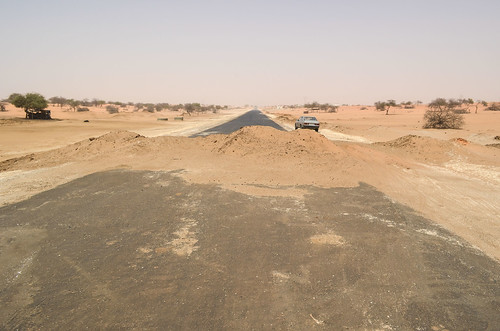
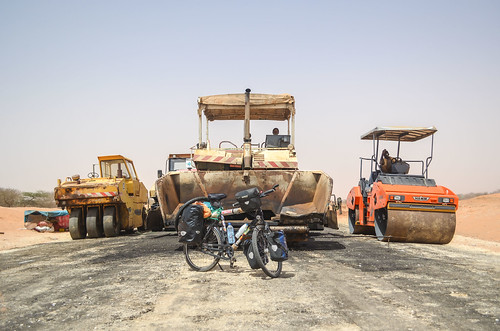
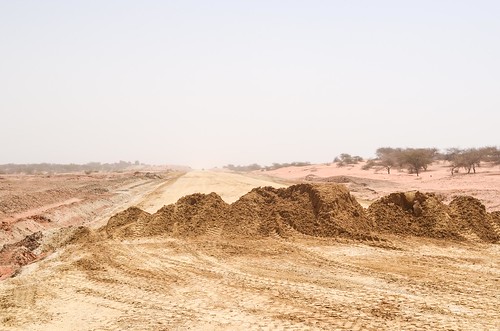
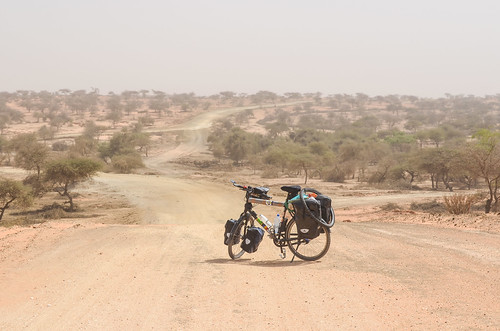
When I ask for tap water in a village, as I am doing since the beginning, I am given water tasting funny with little particles in suspension. It’s time to use my Micropur Forte, a disinfecting liquid where 5 drops can clean a 1.5 L bottle. It’s already a good performance that I didn’t get sick until Senegal (and still counting) with tap water only.
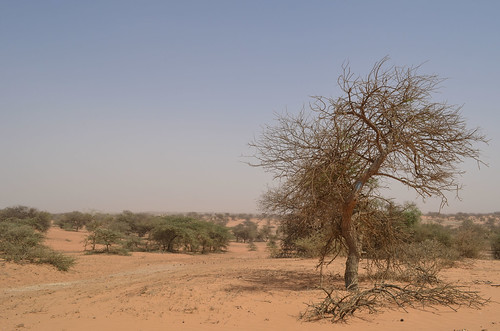
At a turn of the road, the cows bathing in a pond with lots of greenery, contrasting with what I have been seeing for the past month, is a shocking sight for me so used to the desert.

After the village of Keur Macene, I enter the national park of Diawling. I was told many times that there are warthogs “en pagaille” there, and this proved to be true as one with big horns runs in front of me.
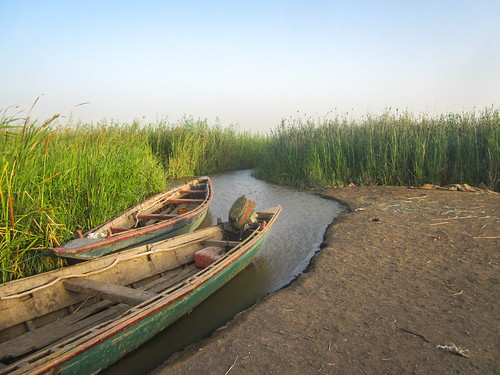
The piste is now following the Senegal river, which marks the entire border with Mauritania, and even further with Mali. I do not cycle along it for a long time today, as it’s almost night and I camp at the gendarmerie checkpoint. I have to look for the gendarme, he doesn’t show up as my bike doesn’t make an engine sound. I am asking the two fishermen there. They greet me by asking for my shirt and my (only) pants, a bit surprising for adults. Later I have dinner with them (fish and rice, no way to run from those 2 for the rest of Africa) and they let me stay in one of their deserted hut. The fisherman who asked to be given my clothes is Senegalese and has 2 wives and 2 houses.
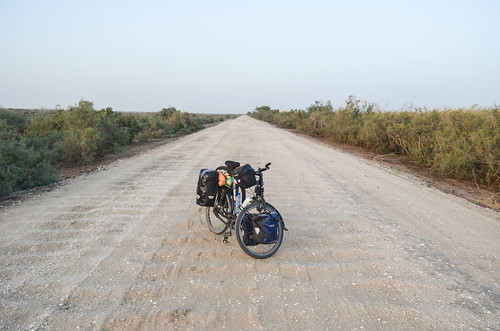
The wind is still terrible at night and I am glad I have a wooden structure to spend a quiet sleep. The sky constellations are all there and some make sense once upside down. For example the Big Dipper with all the stars is really a Great Bear.
Within the strong wind in the morning, the piste has a dust cloud and I can see no further than 30 or 50 meters. So I don’t know where the wild animals hide.

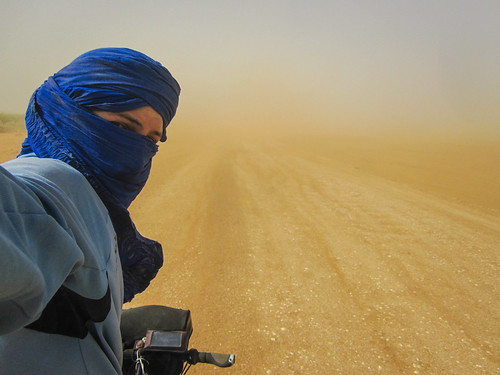
It was so far possible to see camels, cows, donkeys, warthogs and birds at the same time. But a sign announces the presence of crocodiles and snakes too. All are inoffensive, says the guard, in a park where the recommendations are nonexistent compared to the “Stay in your car at all times and never open your window more than 1/3 down” of South African reserves, for example.
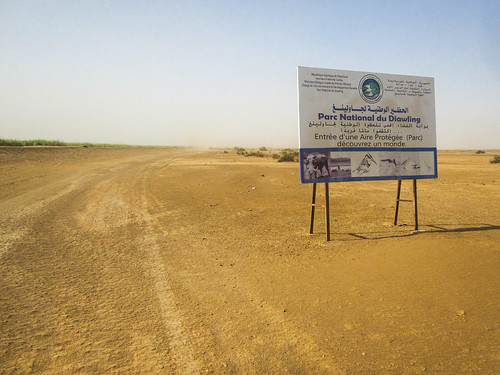
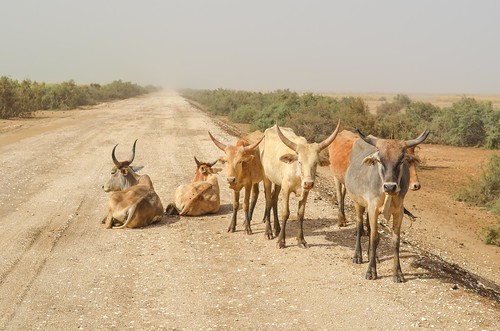
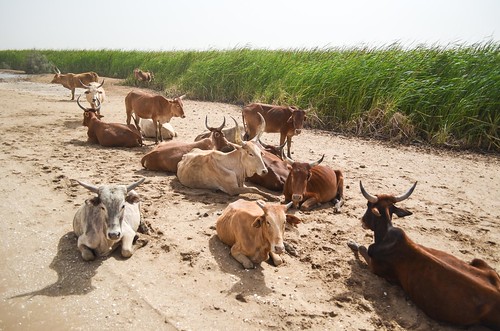
Seeing the warthogs quickly running away from me, it should be rather safe and the only dangerous animals are maybe the border officials.
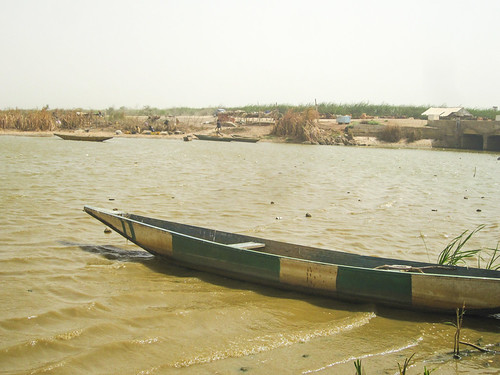



However, the border crossing between Mauritania and Senegal is surprisingly easy and quiet. The seemingly expired dates on my Mauritanian visa didn’t trigger any question or bribe from the police officer. He just had a chat with another one and handed my passport back. It would surely help all travelers to know that this visa lasts 30 days from the day of entry.

The Senegalese border is even more quiet. I learn this April 4th is the 53th anniversary of the independence, and for a national holiday, there is no traffic. And only one man selling souvenirs for tourists. The exchange rates at both sides, despite all the lies from everyone, are much worse than the ones of the changers near the Poste in Saint-Louis. After a joke with the police officer and a demonstration of my gear to the customs, they both let me go without asking for anything.
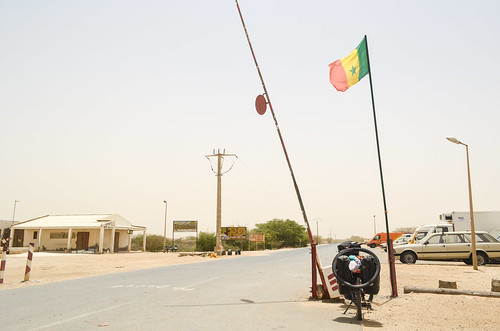
That extremely smooth border crossing combined with a brand new asphalted road starting from the Diama bridge put me in a good mood. The last 32 kilometers to Saint-Louis go by quickly. The road signs are of good quality, they look like in France.

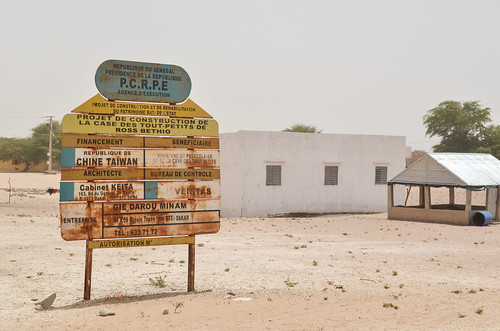
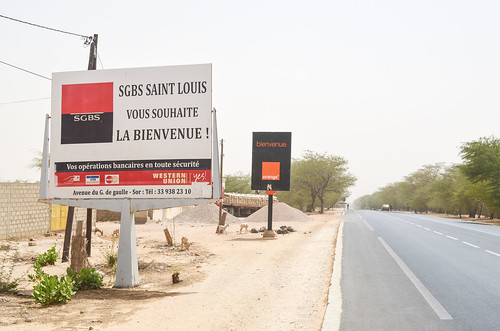
I find in the Saint-Louis camping Jose Luis who cycled really fast since Rabat and we can enjoy a tour in the city. After 3 months in Morocco and Mauritania, I discover a new kind of shop: it has lights, music, it’s called a “bar” and sells beers and other alcohols. Senegal’s population is Muslim at 94% but there seem to be no restrictions.
I would sum up the border shock in 2 factors: the atmosphere that seem much more friendly, where loads of colors, music and smiles are mixed on the streets. Not that the people from previous countries were unfriendly, not at all, but there is a feeling of joy of life here. Secondly, not only the kids but the also adults are begging for things. In a different way. So many times I have heard “Donne-moi ton vélo” or “Donne-moi ton pantalon” (give me your bicycle, your pants) by people looking seriously at me, uttered as naturally as a greeting. It’s such a disconcerting nonsense that I don’t know what to answer yet.







Just a short message to give you courage (hopefully).
It’s great to read your blog and all the stories you live along the road. I’m glad you’ve traveled so far already!
Enjoy Senegal 🙂
Quentin
Dankre!